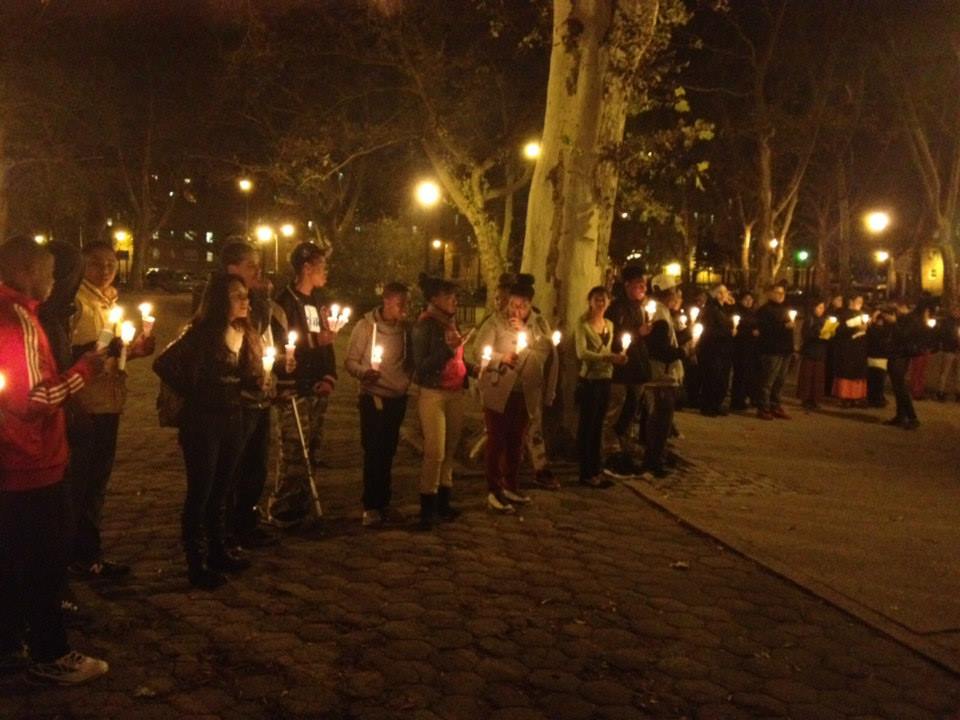Mold Continues To Plague Red Hook Houses, Four Years After Sandy


The Red Hook Houses, Brooklyn’s largest public housing development, continue to grapple with mold and related health impacts four years after Superstorm Sandy, a new report has found.
The report, by the community-based, non-profit Red Hook Initiative (RHI), maintains that flooding endured during Superstorm Sandy exacerbated the development’s existing mold problem, and this long-term exposure to mold “adversely impacts the health of NYCHA (NYC Housing Authority) residents.”
The report’s release last week was first reported by The Daily News.
The Red Hook Initiative says that mold’s impact on indoor air quality at the Red Hook Houses has become a “health crisis.” Infants and children, the elderly, immune- compromised patients, pregnant women, and individuals with asthma and other existing respiratory conditions are especially vulnerable, the group says.
“Mold has been a health threat to NYCHA residents for years, and our findings demonstrate the full extent of this dangerous situation,” said Jill Eisenhard, executive director of Red Hook Initiative. “It is unconscionable that thousands of our neighbors have been living in conditions that put them at risk for asthma, bronchitis and other preventable ailments. It’s time our leaders address this public health problem, and make the development safer for the 6,000 residents who call it home.”
NYCHA officials say that solving the problem is daunting, noting that a 2013 analysis found that its buildings had a 32 percent mold reoccurrence rate, after just 60 days, because of their design and age.
“Over the past year, NYCHA has been making systematic changes to the way we identify, respond and prevent mold by working closely with experts,” a NYCHA spokesman told us by email. “While the Authority is making considerable progress, we remain committed to further improving our methods in identifying and addressing the root causes of mold, drastically reducing reoccurrence rates.”
RHI, which helped to lead area relief efforts immediately after Sandy, says it conducted a community health survey of 280 Red Hook Houses residents from March through August 2016. Nearly all (94 percent) of the respondents said that they have had leaks and/or mold in the past, RHI reported. Forty percent of respondents said they currently have mold in their unit.
Over a quarter of the respondents told RHI that their personal belongings, items like furniture, appliances, clothing and cabinets, had been damaged by leaks and mold.
Mold’s Impact On Health
RIH argues that there is a clear correlation between what it describes as “rampant” mold at the Red Hook Houses and health problems experienced by residents.
According to the Centers for Disease Control, indoor exposure to mold has been linked to upper respiratory tract symptoms, cough, and wheeze in otherwise healthy people; to asthma symptoms in people with asthma; and to other lung diseases.
Over half of the residents who responded to RIH’s survey said that mold and leaks have adversely impacted their health or that of household members. Almost half, 45 percent, said they had at least one family member suffering from a respiratory illness.
Seeking A Response From NYCHA
According to its survey of Red Hook Houses residents, NYCHA has been largely “unresponsive” on the question of mold, RHI says.
Over 140 residents told RHI that they had reported mold to NYCHA authorities in the last year. But only 59 percent of that group say they received a response, RHI reported, and a fraction of the complaints (16 percent) yielded a positive outcome and relief from mold though NYCHA assistance.
NYCHA appears to dispute the number of mold complaints at the Red Hook Houses, telling us that the development currently has a total of 25 open mold complaints submitted by residents.
Local City Council member Carlos Menchaca assailed what he called “NYCHA’s failure to address mold conditions and their unresponsiveness when residents seek help…Remember, mold was an urgent issue on NYCHA properties long before Hurricane Sandy.”
Council Member Ritchie Torres, Chair of the Council’s Committee on Public Housing, said the situation at Red Hook Houses was “unacceptable,” and added that currently “there are no standards in place to fix mold issues in public housing.” Torres said he has introduced legislation that would “require licensing and guidelines for mold remediation work done in NYCHA developments.”
RHI argues that NYCHA cannot solve the mold problem on its own. The City’s Department of Health, Comptroller Scott Stringer, and Red Hook’s elected officials must also commit to finding a long-term solution, the group says.
Among its recommendations, RHI is calling for NYCHA to immediately improve its process for residents seeking mold-related repairs by “adding oversight and a transparent process for residents to track progress and provide feedback.”
RHI is also urging NYCHA to strengthen protection for its residents according to the guidelines set forth by Baez vs. NYCHA. The 2013 court case reaffirmed that NYCHA residents have the right to “effective, safe abatement of mold and excess moisture;” that NYCHA must complete simple repairs in “designated, reasonable timeframes,” and that the agency must accommodate residents with asthma or other health-related conditions.
Preparing For Future Storms & Flooding
What will happen to the Red Hook Houses the next time a coastal storm strikes Brooklyn?
Red Hook Houses East and West are two of 33 NYCHA developments which were collectively awarded $3 billion in FEMA funding last year. The funds will assist NYCHA in making the 33 developments more resilient to future storms and extreme weather. This includes new construction of elevated boilers, installation of flood barrier systems, and acquisition of stand-by generators.
The money is also supposed to go toward critical repairs needed after Sandy’s storm surge flooded basements and first floors, severely damaging boilers and electrical and mechanical equipment, and leaving many residents without power and heat.




